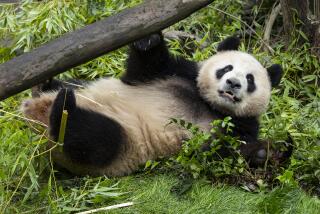Pandas Enjoy a Fertile Summer
- Share via
SHANGHAI — From the outside, there appears to be a panda baby boom going on in China. Three mothers each have given birth to twins. If 10 other females come through, this could be one of the best recent years for the endangered species.
But the mood is hardly euphoric at one breeding ground, the Wolong Giant Panda Protection Research Center in Sichuan province.
“This is definitely not a harvest for us,” Zhang Guiquan, deputy director of the center, said by telephone. “Last year we had 12, which was a record. But this year we’ve only had two so far.”
Though the panda breeding center in Chengdu has had better luck, things looked wobbly from the start for Wolong, the country’s largest breeding ground. Only four pandas at the reserve were artificially inseminated, and two of those efforts went awry early on.
A panda named Bai Xue, or White Snow, ran away into the hills and has not come back. Her keepers worry that forcing her to return would cause her more trauma. She probably escaped through an unlocked gate, Zhang said.
If she gives birth in the wild, it is unlikely that her infant will survive. Pandas raised in captivity tend to abandon their young.
Another expectant mother, Number 28, (named because the staff ran out of fresh ideas, Zhang said) suffered a miscarriage.
But Number 20 came through Saturday with twins, and Number 21 is due to give birth next month.
“But that’s only a maybe,” Zhang said. “You can never know for sure.”
These black-and-white creatures, called xiongmao--”bearcat”--in Chinese, are among the rarest animals in the world. There are fewer than 1,000 of them left in the wild, most of them in Sichuan in central China.
Reproduction is a major challenge. A shrinking natural habitat as well as illegal logging and poaching pose huge threats to their survival.
Chinese scientists describe the bamboo-eating animals as “three-difficult”--difficult to mate, difficult to impregnate and difficult to raise. They say only 10% of all captive male pandas are willing and able to procreate. Only 30% of the females can reproduce.
Of the more than 200 pandas bred since the 1960s through artificial insemination, only about half lived to adulthood. It is unclear how long the captive-bred animals could live in the wild. But their life expectancy is probably lower in zoos. Few have made it into their 30s, said Li Guanghan, director of the Chengdu Giant Panda Breeding Research Center.
Pandas are born tiny--about the length of a finger and weighing less than 10 ounces. Since their mothers are naturally nearsighted, the infants rely on lung power to scream for attention, Li said.
It was considered an auspicious sign when a female delivered two cubs last month at the Chengdu center. It happened on the eve of China’s successful bid for the 2008 Olympics. The public voted to name the twins Shen Shen and Ao Ao, which together mean “Olympic bid.”
Last week, two more pink fur balls tumbled into the world. They were named Ya Guang and Ya Xiang, after their mother, Ya Ya.
Nine other female pandas have been artificially inseminated at the Chengdu center, but “it’s extremely difficult to gauge which one is even pregnant,” said Li, the center’s director. “They are definitely mysterious animals.”
So far, none of China’s captive-bred pandas has been introduced to the wild. It’s simply too risky, keepers say. But environmentalists say that has to change.
A recent study by an international group of scientists indicated that the building of nature preserves designed to protect pandas might actually contribute to their demise. A look at the Wolong sanctuary’s first 11 years showed that its panda population shrunk by half, from 145 to 72. The main culprits are tourists, who finance conservation of the creatures but may also damage the precious forest that gives them shelter.
“Even if you breed 100 or 1,000 pandas in captivity, it is no substitute for the need to protect their natural environment,” said Ouyang Zhiyun, a researcher at China’s Academy of Social Scientists who has studied panda habitats. “That is the next challenge.”
More to Read
Sign up for Essential California
The most important California stories and recommendations in your inbox every morning.
You may occasionally receive promotional content from the Los Angeles Times.













